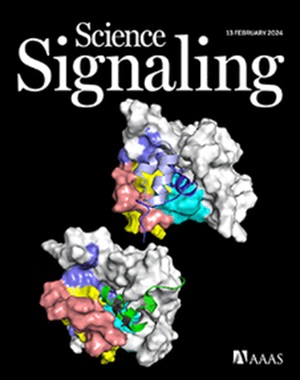Restoration of striatal neuroprotective pathways by kinase inhibitor treatment of Parkinson’s disease–linked LRRK2-mutant mice
IF 6.6
1区 生物学
Q1 BIOCHEMISTRY & MOLECULAR BIOLOGY
引用次数: 0
Abstract
Parkinson’s disease is associated with activating mutations in the gene encoding leucine-rich repeat kinase 2 (LRRK2), which suppresses primary cilia formation in cholinergic and parvalbumin interneurons and astrocytes in the striatum. As a result, there is a decrease in the production of neuroprotective glial cell line–derived neurotrophic factor (GDNF) and neurturin (NRTN), which normally support the viability of dopaminergic neurons. MLi-2 is a brain-penetrant, selective, and now experimental inhibitor of LRRK2. Here, we found that dietary administration of MLi-2 to young LRRK2-mutant mice for 3 months restored primary cilia formation and Hedgehog signaling in both cholinergic and parvalbumin interneurons and astrocytes. The treatment also restored the Hedgehog-responsive expression of Gdnf and Nrtn in the neurons. Cilia were also restored on cholinergic neurons of the pedunculopontine nucleus, where their loss correlates with severity of motor impairment in patients. Furthermore, MLi-2 increased the density of fine striatal dopaminergic processes and decreased the amount of stress-associated Sonic Hedgehog RNA expression in nigral dopaminergic neurons. Thus, pathogenic LRRK2-driven cilia loss is reversible in postmitotic neurons and astrocytes, which suggests that early administration of specific LRRK2 inhibitors may therapeutically benefit patients.
激酶抑制剂治疗帕金森病相关lrrk2突变小鼠纹状体神经保护通路的恢复
帕金森病与编码富含亮氨酸重复激酶2 (LRRK2)的基因激活突变有关,该基因抑制纹状体中胆碱能和小白蛋白中间神经元和星形胶质细胞的初级纤毛形成。因此,神经保护胶质细胞系衍生的神经营养因子(GDNF)和神经蛋白(NRTN)的产生减少,这两种物质通常支持多巴胺能神经元的活力。MLi-2是一种脑渗透、选择性的LRRK2抑制剂,目前处于实验阶段。在这里,我们发现年轻的lrrk2突变小鼠在饮食中给予MLi-2 3个月后,可以恢复原发纤毛的形成以及胆碱能和小白蛋白中间神经元和星形胶质细胞中的刺猬信号。该处理还恢复了神经元中Gdnf和Nrtn的刺猬应答性表达。桥脚核胆碱能神经元上的纤毛也得到了恢复,纤毛的丢失与患者运动障碍的严重程度有关。此外,MLi-2增加了细纹状体多巴胺能过程的密度,降低了黑质多巴胺能神经元中与应激相关的Sonic Hedgehog RNA的表达量。因此,致病性LRRK2驱动的纤毛丢失在有丝分裂后神经元和星形胶质细胞中是可逆的,这表明早期给予特异性LRRK2抑制剂可能对患者有治疗益处。
本文章由计算机程序翻译,如有差异,请以英文原文为准。
求助全文
约1分钟内获得全文
求助全文
来源期刊

Science Signaling
BIOCHEMISTRY & MOLECULAR BIOLOGY-CELL BIOLOGY
CiteScore
9.50
自引率
0.00%
发文量
148
审稿时长
3-8 weeks
期刊介绍:
"Science Signaling" is a reputable, peer-reviewed journal dedicated to the exploration of cell communication mechanisms, offering a comprehensive view of the intricate processes that govern cellular regulation. This journal, published weekly online by the American Association for the Advancement of Science (AAAS), is a go-to resource for the latest research in cell signaling and its various facets.
The journal's scope encompasses a broad range of topics, including the study of signaling networks, synthetic biology, systems biology, and the application of these findings in drug discovery. It also delves into the computational and modeling aspects of regulatory pathways, providing insights into how cells communicate and respond to their environment.
In addition to publishing full-length articles that report on groundbreaking research, "Science Signaling" also features reviews that synthesize current knowledge in the field, focus articles that highlight specific areas of interest, and editor-written highlights that draw attention to particularly significant studies. This mix of content ensures that the journal serves as a valuable resource for both researchers and professionals looking to stay abreast of the latest advancements in cell communication science.
 求助内容:
求助内容: 应助结果提醒方式:
应助结果提醒方式:


